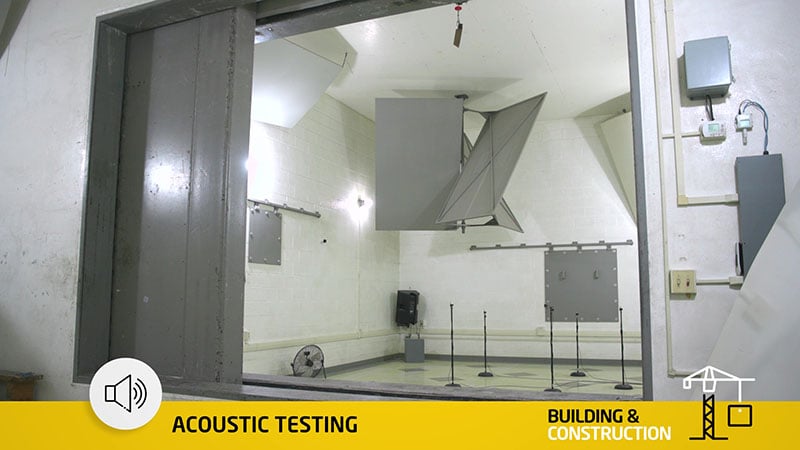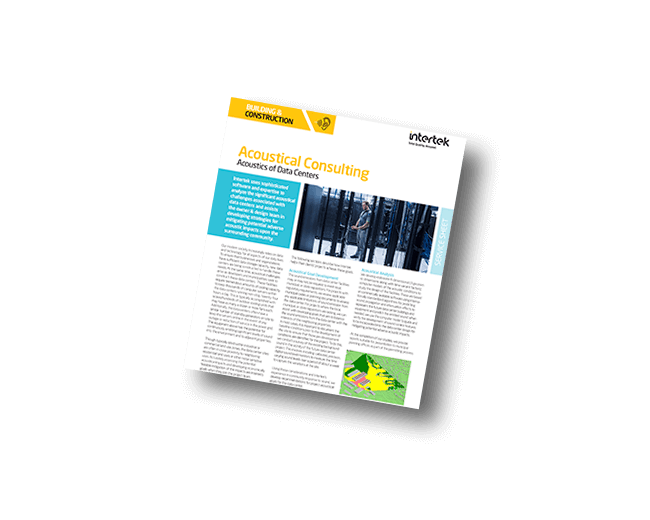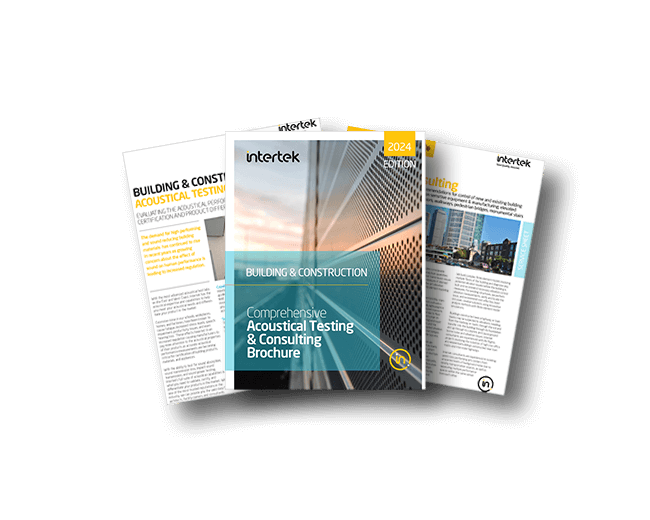Utilize our full suite of Acoustical Performance Testing capabilities to assess your building products and systems
The Role of Acoustics in Building Design and Construction
In today's world, acoustics play a crucial role in building design and construction. Sound can significantly impact occupant comfort, health, productivity, and safety.
Building projects require expertise in noise control, vibration mitigation, and sound optimization to achieve optimal acoustic performance. Intertek, a global leader in quality assurance and testing, offers a comprehensive range of building construction acoustical services. These include testing, consulting, LEED® consulting, and product certifications, among others.
Acoustical Testing
Acoustical testing measures how effectively products like windows, doors, and walls manage sound, keeping unwanted noise from sources such as traffic and neighbors out of living spaces. This helps manufacturers refine their designs for enhanced noise reduction. Intertek tests a wide range of building products and technologies, including traditional materials like walls and floors and advanced solutions such as noise-absorbing panels and smart acoustic systems.

Intertek's Acoustical Testing
Accredited Acoustical Lab Testing
Intertek's accredited acoustical lab testing leverages a global network of state-of-the-art facilities and deep expertise in building product testing to help you achieve optimal acoustic performance and expand your brand's reach in multiple markets worldwide. The laboratories, operated by skilled experts, deliver reliable data and comprehensive reports, ensuring your products meet acoustic performance standards and contribute to a well-designed soundscape in your final project.
Accredited by various national and international standards bodies, Intertek's laboratories offer:
- Sound Transmission Loss (STL) Testing: Measuring how well walls, floors, and ceilings block sound.
- Sound Absorption Testing: Determining the ability of materials to absorb sound and reduce reverberation.
- Impact Sound Insulation (IIC) Testing: Assessing the noise generated by footfall on various floor structures.
- Airborne Sound Insulation (STC) Testing: Measuring the ability of walls and doors to block airborne noise.
Acoustical Field Testing
Intertek has a mobile and easy-to-access field acoustic team that tests your products in real-world conditions. Like our laboratory tests, results are provided in real-time with immediate tabular and graphical performance analysis.
- Apparent Sound Transmission Classification (ASTC): ASTC is a field-measured rating using the test method from ASTM E336.
- Outdoor/Indoor Transmission Class (OITC): OITC is a number rating of the sound transmission loss of a constructed assembly tested with lower frequencies to represent sound typical of modes of transportation.
- Apparent Impact Insulation Class (AIIC): AIIC is the insulation index of the apparent impact noise of a floor/ceiling assembly on site. Since ASTM E1007-14 and ASTM E336-14 came to affect, details have been provided on how to measure and present the results of acoustic tests carried out on site.
- Noise Isolation Class (NIC): NIC is a single number (like STC) expressing the actual degree of sound control between two adjoining areas measured at various frequency levels (pitches), on site in a building and is commonly referred to as a "Field Test". The higher the number the better the control.
Noise Assessments
At Intertek, we carry out detailed noise assessments, also known as noise impact assessments or noise surveys, to protect the well-being and safety of workers, comply with noise regulations, and reduce the impact of noise on nearby communities and the environment. These assessments are crucial for understanding and managing the impact of noise produced from sources like industrial activities, construction, transportation, and commercial operations.
Acoustical Consulting
Acoustic quality significantly impacts building occupants' performance, stress levels, and overall wellness. High-quality acoustic environments increase productivity and improve health, while unmanaged interior and exterior noise and vibration sources can undermine these benefits. Intertek has a team of acoustic consultants and engineers who help clients optimize acoustic environments in new and existing buildings. We provide expert guidance throughout the project lifecycle, from initial planning and design to construction to post-occupancy evaluation. Our acoustical consulting can help ensure your building project meets all applicable acoustical needs and requirements.
Projects can introduce noise or vibration to the environment or conversely, future developments can be impacted by existing sources of noise & vibration. Intertek can help project personnel to interpret local, state and federal noise regulations, ordinances, and guidelines and has the expertise to assist the project in achieving its community goals. Whether it is noise from rooftop mechanical systems bothering nearby residents, or vibrations from transit systems impacting a sensitive development, Intertek BSS-NAV can identify project objectives, assess environmental noise & vibration problems and develop solutions to achieve the project goals or environmental requirements.
Our experienced and creatively inspired team of acousticians and engineers performs acoustic and vibration analyses and consulting for the design of new or renovation projects. We collaborate with architects, developers, contractors, building owners, and occupants to identify how to optimize acoustic and vibration conditions for their project goals. Our approach to projects provides clients with clear and concise deliverables in all stages of design and construction. With over 100 years of combined industry experience, our staff provides resourceful acoustic and vibration feedback for various project types.
Intertek uses modern computer modeling tools to analyze and visualize the predicted acoustic and vibration conditions of our projects. We can provide detailed predictions of interior and exterior sound propagation using 3-D computer modeling software. Our exterior acoustic models provide insight for designers to select building enclosures and noise control for mechanical systems to meet the project’s acoustic goals on the project site or for the community.
Interior acoustic models help to predict a wide range of acoustic characteristics within rooms and spaces to help with the shaping of rooms, selection of acoustic finishes, and placement and directivity of loudspeakers to optimize the sound for the occupants. This process assists the ownership and design teams with how various design options may affect the future acoustic conditions in these rooms.
Vibration modeling helps to predict whether vibration will be feelable within the building and whether it is likely to disturb the occupants or exceed project goals, such as acceptable levels for vibration sensitive equipment. Vibration model results can also be used to predict whether the vibration will be perceptible as groundborne or structureborne noise. Results from the vibration modeling provide the design team with insights towards modifications that can be made to the structure to reduce vibration, if needed. Finally, vibration modeling helps evaluate the effectiveness of structural design modifications to achieve the project goals.
Visualization of the modeling results allows design teams to better understand the predictions of the future acoustic and vibration environment and address acoustic and vibration issues in the early stages of a project’s design.
Beyond the numerical and visualized results from state-of-the-art acoustic modeling software, BSS-NAV develops audio simulations to allow the acoustic conditions within spaces to be heard long before they are built. This process, known as “auralization”, is helpful for owners, designers and decision-makers in selecting design options, which often may affect the project budget.
Auralizations of rooms allow listeners to experience the effectiveness of sound absorbing finishes and room shaping to ensure that their spaces have the desired acoustics for engaging musical performances or providing clear and understandable speech. Hearing a space before construction aids the decision-making process early in the design, saving the potential cost of post-construction modifications.
Auralizations of other acoustic conditions allow for the listeners to hear the isolation or transmission of sound into spaces from exterior or interior sources. The auralization of the acoustic isolation performance of demising assemblies or the transmission of groundborne/structureborne noise into a space allows the owner, designers, and contractors to better understand the value of recommended isolation treatments toward achieving project acoustic goals.
Using calibrated equipment, we perform a wide variety of acoustic and vibration measurements to quantify sound and vibration levels. These measurements may assess the compliance of noise sources with applicable ordinances or inform designers of sound levels near their project sites, such as nearby traffic or aircraft, which can adversely affect acoustic and vibration conditions within the project. These measurements help designers and architects understand how the environment they are building in or around will affect their project and how their project will affect the surrounding environment.
Our BSS-NAV team performs standardized acoustic and vibration field tests in accordance with industry standards to assess the sound and vibration levels at greenfield and brownfield sites, code compliance of demising assemblies, the performance of acoustically rated systems, the decay of sound within spaces, the sound and vibration levels of mechanical systems, and more. We perform measurements to the following acoustic and vibration standards:
Acoustic commissioning involves the peer review of existing, renovation or new construction projects for owners to help ensure that the facility achieves the Owners Project Requirements (OPR), LEED credits, WELL Sound Features or other project objectives. Our staff has experience peer reviewing documents prepared by other acoustic consultants to confirm the design is consistent with the stated acoustic performance objectives, providing collaborative feedback for resolving any deficiencies in the design. During construction, our team provides thorough inspections of the acoustical elements of projects to observe that the execution of the design is consistent with the project goals. We work with the designers and contractors to provide project-specific acoustic and vibration solutions for problems that may arise in the field and collaborate with the project team from design through to occupancy.
Our staff has experience with providing expert witness services for public hearings or litigation with focus on clear and concise communication and attention to detail. Our acoustic specialists present testimony and opinions allowing complex technical issues to be understood by laypeople. Our experience ranges from acoustical complaints with residential projects, corporate facilities, higher education facilities, industrial complexes, community noise and vibration conditions and accident investigations. We can support litigation through assessments, measurements, or testing, and extensive analyses, modeling and simulations of the conditions. Our litigation support has been successful for our clients toward proving their side of the conditions.
Sound is often an important facet in users’ or consumers’ perception of a product’s quality or craftsmanship. This service may be sought for products to achieve acoustical criteria for various international markets. Minimizing noises that are harsh or abrasive and enhancing sounds that promote positive impressions of the product are the unique balance of this consulting effort, which result in products that have a sound that is more desirable. Our team can provide acoustic and vibration feedback and recommendations for product developers to ensure that their products are designed with sound quality in mind.
Acoustical Consulting for LEED
Acoustics are critical in achieving LEED certification as effective sound management enhances building performance and occupant satisfaction. Quality acoustics improve occupants' health, productivity, and well-being, minimizing noise distractions and creating a more comfortable environment. Enhanced Acoustic Performance offers two credits within the Indoor Environmental Quality (EQ), while selecting appropriate acoustical materials can help with Materials and Resource credits and energy efficient, low-noise building systems can also help with Energy and Atmosphere (EA) categories. Partnering with Intertek provides access to a specialized with extensive knowledge of the LEED certification process. Furthermore, Intertek has experience with pursuing pilot credits that can help earn additional credits beyond the standard offerings. In the end, we will help your project meet LEED prerequisites and credits and guide you seamlessly from the initial assessment to the final certification.
Acoustical Product Certification
Intertek helps manufacturers obtain independent verification of their products' acoustic performance through its ETL Certification program. This enhances product credibility and competitiveness in the market.
International Standards for Acoustics
ASTM International develops and publishes a wide array of standards for acoustical testing and measurement. These standards are used worldwide to ensure the quality and performance of building products and to create acoustically comfortable environments. Some of the key ASTM standards for acoustics include:
ASTM E90
Standard test method for laboratory measurement of airborne sound transmission loss of building partitions and elements.
ASTM E492
Standard test method for laboratory measurement of impact sound transmission through floor-ceiling assemblies using the tapping machine.
ASTM E336
Standard test method for measurement of airborne sound attenuation between rooms in buildings.
ASTM E1007
Standard test method for measurement of tapping machine impact sound transmission through floor-ceiling assemblies and associated support structure.
ASTM E2179
Standard test method for laboratory measurement of the effectiveness of floor coverings in reducing impact should transmission through concrete floors.
ASTM E1414
Standard test method for airborne sound attenuation between rooms sharing a common ceiling plenum.
ASTM E2235
Standard test method for determination of decay rates for use in sound insulation test methods.
Acoustical Accreditations
Testing your building products and obtaining results from an accredited laboratory significantly strengthens your position in securing regulatory approvals and demonstrating compliance with project specifications. Intertek's laboratories are all accredited, ensuring the highest standards of quality and reliability.
Partnering with an accredited Intertek laboratory for acoustical testing offers several key advantages, including quality assurance. Accreditation also guarantees that the testing process follows established quality management systems, which minimizes the risk of errors and ensures the accuracy of your results. Among the accreditations are:
International Accreditation Service (IAS): IAS accreditation covers Intertek's acoustical testing capabilities across various standards, including ASTM International, the International Organization for Standardization (ISO), and the American National Standards Institute (ANSI). This accreditation demonstrates our ability to conduct a broad range of tests while adhering to rigorous international standards.
NVLAP accreditation recognizes Intertek's expertise in testing building products for compliance with national standards such as the International Building Code (IBC). This accreditation is crucial for manufacturers seeking to sell their products in the U.S. market.
Certificate of Accreditation to ISO/IEC 17025:2017
SCOPE OF ACCREDITATION TO ISO/IEC 17025:2017
Worldwide accreditations enhance the credibility of your test reports, facilitating trade and market access for building products. Our team of experts is knowledgeable about both national and international standards, ensuring your products comply with regulations in any market you target. We navigate complex regulations and tailor testing to specific market requirements, helping you access new markets worldwide
Depending on your project's specific needs, Intertek may also hold additional accreditations from regional or industry-specific bodies, such as the International Code Council Evaluation Service (ICC-ES), the European Organization for Technical Approvals (EOTA), or the Canadian Standards Association (CSA).
Intertek's Comprehensive Solutions for Acoustics
Intertek is committed to delivering comprehensive solutions for your acoustical needs in building projects. Our focus is on ensuring that your project adheres to regulatory standards, achieves optimal acoustic performance, and supports the health and safety of building employees.
Contact us to learn more about Intertek's Acoustical Consulting, Acoustical Testing, and Noise Assessments for building products.
Knowledge Center
Building Health & Wellness: An Overview of Services
Acoustical Testing & Consulting Resources
Remote Pre Inspections for NFPA 80 / 101
Protek - Safety. Everywhere. Every Day
Fire Doors 101: Your Guide to Testing and Certification - Webinar Recording
Tornado Testing & Certification Requirements - Webinar Recording
Plumbing Products Testing & Certification - Webinar Recording
The Evolving Code Evaluation Process White Paper
Proposition 65 & the Furniture Industry Webinar Recording
Why Planning for FCC Certification is Key to Success in the Door Hardware Industry White Paper

Upcoming Tradeshows & Events
Resources
- Search and Buy Building & Construction Standards
- SpecDirect
- Building Products Directory
- Project Connect (formerly myATI) – B&C Products
- Construction Hive – B&C Projects (PSIQest)
- My TestCentral



